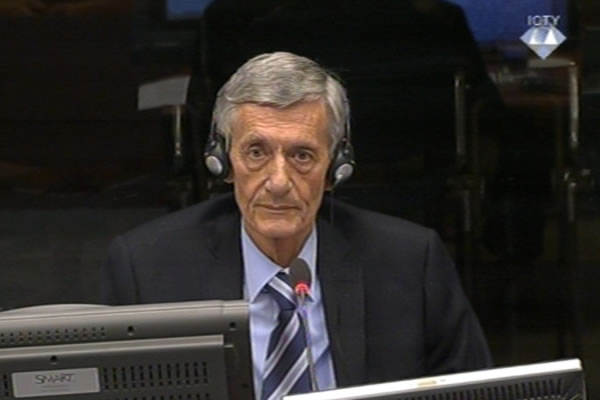Home
KARADZIC’S EXPERT WITNESS OFFERS ‘APPROXIMATE’ ANALYSIS
The prosecution notes that defense expert Radovan Radinovic, in a bid to justify the attacks of the Bosnian Serb army on Sarajevo, estimated the number of military targets in Sarajevo at 1,500 when he testified at Stanislav Galic’s trial. In his book, he increased the figure to 1,800. In a report he wrote for Karadzic’s defense, the figure went up again, to 2,000. Yesterday, as he testified in court, it went up again, to 2,200. The witness defended his claims saying that his calculations were ‘approximations’
 Radovan Radinovic, defence witness of Radovan Karadzic
Radovan Radinovic, defence witness of Radovan Karadzic In the cross-examination of defense military expert Radovan Radinovic, prosecutor Uertz Retzlaff put it to the witness that the chain of command in the Bosnian Serb army functioned smoothly from top to bottom, from Karadzic, who was the president and supreme commander, through the Main Staff down to the smallest units in the field. She thus contested the claims made by General Radinovic who tried to play down the command authority of the accused, noting that there was ‘duality of command’ in the Bosnian Serb army. According to him, there was constant conflict between Karadzic and the Main Staff commander Ratko Mladic.
The prosecutor first showed the witness a book written by General Manojlo Milovanovic, ‘My View of the War in Bosnia’, where the author states that in practice, ‘the Main Staff was the staff of the Supreme Command’ and that the war strategic objectives were implemented ‘despite the internal strife among Serbs’. When the prosecutor asked the witness if Milovanovic, as Mladic’s chief of staff, might have been better placed that he was to know about the war situation, the witness said, ‘he cannot know more than I do, I taught him at school’. An analysis of the VRS combat readiness for 1992 states that command and control were ‘unified’. In a speech from 1993, Karadzic himself says that command is ‘unified’ and based on ‘consensus’. He also says that he has approved all the operations.
General Radinovic replied that he never claimed that the accused did not have control over the army: he did not have ‘operational power’. He admitted that the operations were carried out with the knowledge of the accused and that the accused received regular reports about their course.
The fact that in June 1994 Karadzic promoted Mladic shows, as the prosecution alleges, that the RS president and the Main Staff commander were on good terms. The witness did not see this as strange, because in his opinion Mladic was a good soldier who deserved a promotion.
Yesterday, Radinovic said, in a bid to justify VRS attacks on Sarajevo, that there were 2,200 military targets in the city. The prosecutor noted that he had presented different figures in various analyses. The first figure, in a report Radinovic wrote for the defense of the Sarajevo-Romanija commander Stanislav Galic, was 1,500. In a book he wrote, he increased the number to 1,800 military targets. In the current expert report written for the Karadzic case, the number of military targets is estimated at 2,000, only to go up again yesterday in court to 2,200. Radinovic said his calculations were ‘approximate’, not exact. The purpose was to show that the city was ‘buried in’ military targets. When he was asked if he still maintained that ‘the entire Sarajevo was a military target’, the witness qualified his statement, saying, ‘it’s not that the entire city was a target, but for all intents and purposes, it practically was’.
As the hearing drew to a close, prosecutor Mitchell started cross-examining Radinovic. He will deal with Srebrenica. Radinovic’s evidence will continue tomorrow. General Svetozar Andric is also expected to testify tomorrow; he has been subpoenaed to testify in The Hague.
Linked Reports
- Case : Karadzic
- 2013-07-17 EXPERT WITNESS DENIES CRIMES IN BH
- 2013-07-16 KARADZIC WANTS TO SEVER COUNT 1
- 2013-07-16 IDIOTS THAT ORDERED ATTACK ON SREBRENICA
- 2013-07-19 HOW SREBRENICA OPERATION TURNED INTO A CRIME
- 2013-07-22 WITNESS WITH ‘CLEAR CONSCIENCE’ AND PROBLEMATIC PAST
- 2013-07-23 KARADZIC’S EXPERT PREPARED TO ACCEPT JUST 500 SREBRENICA VICTIMS
